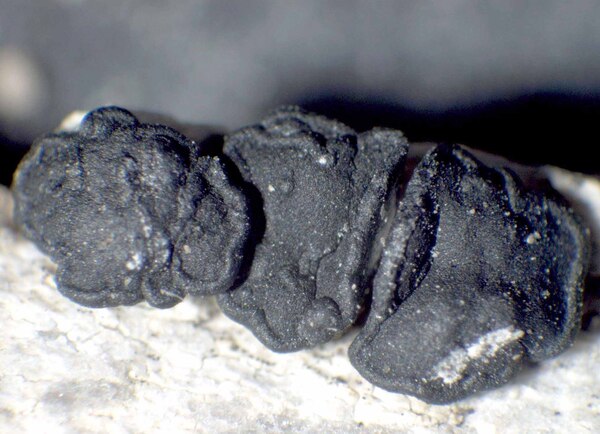Adelolecia kolaensis (Nyl.) Hertel & Rambold
Bibl. Lichenol, 57: 214, 1995. Basionym: Lecidea kolaensis Nyl. - Flora, 46: 306, 1863.
Synonyms: Catillaria tavastiana H. Magn.; Lecidea conferenda Nyl.; Lecidea dolosula (Nyl.) Vain.; Lecidea migratoria Lynge; Lecidea umbratilis (Arnold) Th. Fr.; Lecidella umbratilis Arnold
Distribution: N - TAA (Hertel & Rambold 1995, Nascimbene & al. 2022), Piem (Isocrono & al. 2003), VA (Piervittori & Isocrono 1997, 1999, Piervittori & al. 2004, Isocrono & al. 2008, Favero-Longo & Piervittori 2009).
Description: Thallus crustose, very variable, from endosubstratic to rimose-areolate or even bullate-areolate, dirty white to ash-grey. Cortex 15-30 μm thick, colourless or pale brown; medulla white, I-. Apothecia lecideine, black, sessile and strongly constricted at base, 0.2-0.6(-1) mm across, with an initially flat, then convex, sometimes botryose, epruinose disc, and a very thin, finally often excluded proper margin. Proper exciple 25-45 μm wide, of radialy arranged hyphae, dark to pale green in outer part, colourless within, K-; epithecium blue-green to rarely olive-green, N+ reddish, 2-10 μm high; hymenium colourless or pale blue-green, 35-60 μm high, I+ blue; paraphyses mostly simple, strongly coherent, 1.7-2 μm thick at mid-level, the apical cells to 5 μm wide; hypothecium colourless in lower part, pale blue-green or pale violet in upper part, 20-200 μm high. Asci 8-spored, clavate, with a K/I+ blue apical dome penetrated by a narrow, K/I- apical cushion surrounded by a narrow, deeply K/I+ blue zone, the wall K/I- but surrounded by an I+ red-brown, K/I+ blue outer layer, the ocular chamber relatively small, Biatora-type. Ascospores 1-celled to rarely 1-septate, hyaline, ellipsoid to narrowly ellipsoid, (6.5-)8-11(-18) x (2.5-)3-5(-6) μm. Pycnidia dark brown to black. Conidia bacilliform, 4-9 x 0.6-1.4 μm. Photobiont chlorococcoid. Spot tests: thallus K-, C-, KC-, UV-. Chemistry: without lichen substances.Note: an arctic-alpine, probably circumpolar species of basic to weakly calciferous siliceous rocks in exposed situations, with optimum above treeline. For further details see Hertel & Rambold (1995). Earlier records of Lecidea conferenda from Liguria, Tuscany and Sardinia (see Nimis 1993: 380), being dubious, are not accepted here.
Growth form: Crustose
Substrata: rocks
Photobiont: green algae other than Trentepohlia
Reproductive strategy: mainly sexual
In underhangs rarely wetted by rain
Commonnes-rarity: (info)
Alpine belt: rare
Subalpine belt: rather rare
Oromediterranean belt: absent
Montane belt: absent
Submediterranean belt: absent
Padanian area: absent
Humid submediterranean belt: absent
Humid mediterranean belt: absent
Dry mediterranean belt: absent

Predictive model
Herbarium samples
Growth form: Crustose
Substrata: rocks
Photobiont: green algae other than Trentepohlia
Reproductive strategy: mainly sexual
In underhangs rarely wetted by rain
Commonnes-rarity: (info)
Alpine belt: rare
Subalpine belt: rather rare
Oromediterranean belt: absent
Montane belt: absent
Submediterranean belt: absent
Padanian area: absent
Humid submediterranean belt: absent
Humid mediterranean belt: absent
Dry mediterranean belt: absent

Predictive model
| Herbarium samples |
 Index Fungorum
Index Fungorum
 GBIF
GBIF



